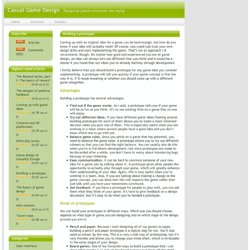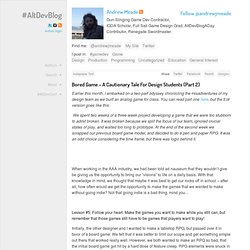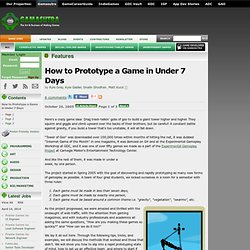

Casual Game Design » Building a prototype. Coming up with an original idea for a game can be hard enough, but how do you know if your idea will actually work?

Of course, you could just trust your own design skills and start implementing the game. That’s not an approach I’d recommend, though. Prototype early and often - Prototype early and often. Problem summary Design problems are typically complex, “ill-structured” and can only be well understood through exploration.

As a result, there are many subtle, but critical questions about these problems that only learners themselves can answer. The trick lies in finding how to find what the questions are, and how to ask them. Discussion Most learning problems that are worth solving well are typical of design problems in general. The people who, at some level, know the problem best are, of course, learners. What learners often need in order to make effective contributions to the design debate is some form of representation of a solution (or its parts) that they can comment on, play with and explore. The application of prototyping in some design environments – particularly in the e-learning industry – does not make best use of prototyping.
Recommendations But using prototypes in this way challenges a number practices common in the e-learning industry. Paper Prototyping: 5 Facts for Designing in Low-Tech. Paper Prototyping: 5 Facts for Designing in Low-Tech. Lost Garden. The Usability Methods Toolbox - Usability Methods Toolbox Contextual Design Heuristic Evaluation Inspection Inquiry usable engineering. Prototyping: You’re (Probably) Doing It Wrong. You’re not alone, I was also doing prototyping wrong until a few years ago.

There are probably many different ways of prototyping games correctly, and maybe your way works great for you. In that case, a more accurate title for this post could have been “Prototyping: I Was Doing It Wrong”. A good game prototype is something fast/cheap that allows you to answer a specific question about your game. The key points there are fast/cheap and specific question. It’s not a level of a game, it’s not a “vertical slice”, and it’s certainly not an engine for the game.
Chris Hecker and Chaim Gingold gave one of the best presentations on the subject of rapid prototyping. Mistake #1: Going With The First Idea Every company I’ve ever worked at has done this mistake. » How To Fail At Prototype Design » Farshid Palad. Bored Game – A Cautionary Tale For Design Students (Part 2) Earlier this month, I embarked on a two-part odyssey chronicling the misadventures of my design team as we built an analog game for class.

You can read part one here, but the tl;dr version goes like this: We spent two weeks of a three-week project developing a game that we were too stubborn to admit broken. It was broken because we split the focus of our team, ignored crucial states of play, and waited too long to prototype. At the end of the second week we scrapped our previous board game model, and decided to do a pen and paper RPG. It was an odd choice considering the time frame, but there was logic behind it. When working in the AAA industry, we had been told ad nauseum that they wouldn’t give be giving us the opportunity to bring our “visions” to life on a daily basis.
Lesson #5: Follow your heart. Initially, the other designer and I wanted to make a tabletop RPG, but passed over it in favor of a board game. So we sprung to action. Paper Prototyping – Putting Your Games on Paper » #AltDevBlogADay. Potential game ideas; every game developer has them. Ask any game developer and I am sure that they have some great game ideas that they would pursue if given the opportunity. Some people think these game ideas aren’t really useful; but it really depends on the application. Making of MGS2 1. Making of Metal Gear Solid 2 Sons Of Liberty Part 1. Game Prototyping 101. This article tells you how to get started with game prototyping.

Prototypes can be analog or digital, made out of paper, assembler, clay or python. They can take any shape or form, but still share some key properties. The reason for a prototype is always that you want to test a specific feature, technique or design decision as cheap as possible. In order to make the prototype cheap, it needs to be easy to create and fast to get started. Use whatever is at hand or, even better, create a prototyping environment. In summary, a prototype has the following key properties: Easy to create, fast to get startedCheap to work with, so that you can throw away the resultsShould not produce something you can use in finished productShould not allow optimizationBe made with the right tool for this specific design challengeAllows to judge one specific aspect of design The problem with prototypes is that they sound like extra work.
Proto - "Google Docs" Features - How to Prototype a Game in Under 7 Days. Here's a crazy game idea: Drag trash-talkin' gobs of goo to build a giant tower higher and higher.

They squirm and giggle and climb upward over the backs of their brothers, but be careful! A constant battle against gravity, if you build a tower that's too unstable, it will all fall down. "Tower of Goo" was downloaded over 100,000 times within months of hitting the net, it was dubbed “Internet Game of the Month” in one magazine, it was demoed on G4 and at the Experimental Gameplay Workshop at GDC, and it was one of over fifty games we made as a part of the Experimental Gameplay Project at Carnegie Mellon's Entertainment Technology Center. And like the rest of them, it was made in under a week, by one person. The project started in Spring 2005 with the goal of discovering and rapidly prototyping as many new forms of gameplay as possible. 1. We lay it all out here. For easy browsing, all tips and tricks are organized into four sections: Setup, Design, Development, and General Gameplay. 1.